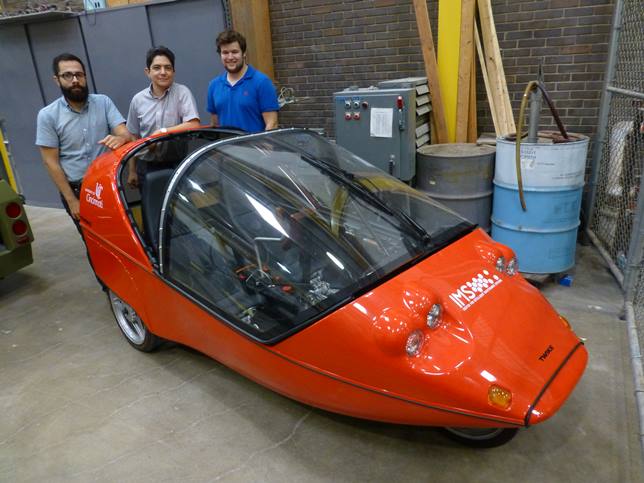Source: mnn.com
Published: August 29, 2014

The author in the Twike driver’s seat with Mohammed Rezvani of the University of Cincinnati. (Photo: Jim Motavalli)
Meet the Twike. It’s a made-in-Germany combination of an electric bicycle with an EV. It may be that we’ll see more of these hybrids popping up as our cities get less friendly to gas guzzlers. Driving 60 miles is going to cost you $2, the company says.
 The Twike you’re looking at is one of the few in the U.S., and it’s being used as a test bed by the Center for Intelligent Maintenance Systems (IMS) at the University of Cincinnati. The center is working on something like Big Data for smart batteries, turning these mysterious devices into information centers that, according to doctoral student Mohammad Rezvani, can tell their users when cells are underperforming and maximize their efficiency.
The Twike you’re looking at is one of the few in the U.S., and it’s being used as a test bed by the Center for Intelligent Maintenance Systems (IMS) at the University of Cincinnati. The center is working on something like Big Data for smart batteries, turning these mysterious devices into information centers that, according to doctoral student Mohammad Rezvani, can tell their users when cells are underperforming and maximize their efficiency.
The University of Cincinnati’s smart battery team with the Twike. (Photo: Jim Motavalli)
The big drawback of the Twike is the price, around $27,000 for the base model, and you’re going to want to add some options. But it’s a superbly engineered “hybrid” vehicle (pedal power and battery assist) that can reach 52 mph and cruise up to 300 miles on a charge. One drives with a central tiller (as in the earliest days of motoring), and the passenger in this two-seater can pedal, too. Human assist really extends the range. For al fresco driving, the central plastic canopy is removable. The Cincinnati guys tell me it can get quite warm with the top in place.
There are about 1,000 Twikes on European roads that have covered 37 million miles, but very few in the U.S. It can be registered as a motorcycle, which means you don’t need airbags and crash tests.
The made-in-America equivalent of the Twike is another three-wheeler named the ELF, which I’ve had the pleasure of pedaling around places as diverse as Darien, Connecticut and Chattanooga, Tennessee. The ELF, built by Organic Transit, isn’t quite as luxurious as the Twike, but it’s a lot cheaper — $5,495 for the standard model. The company is ramping up production and wants to be making thousands of ELFs per year.
Plastic-bodied ELFs weigh only 150 pounds, achieve 1,800 mpg (the company says), and can reach 20 mph, with 15 miles of electric range — though you can triple that by pedaling a lot. It’s also possible to extend the range by adding extra e-bike type li-ion battery packs. One enterprising owner even drove an ELF from the company’s Durham, North Carolina base to his home in Boston. That’s a lot to ask from an ELF, which lacks basic suspension and is jolting over rough pavement.

Organic Transit’s ELF on its way to Boston. (Photo: Jim Motavalli)
Rob Cotter, CEO and founder of Organic Transit, describes the Twike and ELF as “the same but different. The weight of a Twike is almost 4X an ELF, so the gains from pedaling (or solar panels) are less. That said, I loved it the first time I saw one at the Vancouver World’s Fair around 1987. It was sponsored by Lufthansa, and looked basically identical to today’s Twike. I’m sure it has a lot more power [than the ELF].”
I’m bullish on these neighborhood-type trikes, which make great commuter vehicles. Highway friendly, they’re not, but OK on lightly trafficked local roads.
The smart battery research at the University of Cincinnati is interesting. According to Jay Lee, the IMS director, the cells in a battery pack typically degrade (and charge) at different rates, and that throws off the efficiency and longevity. If every part of the pack can be monitored with the kind of Big Data equipment that’s now hugely in vogue, one bad apple won’t spoil the whole bunch and owners would be left with a much more satisfying experience. “You want to be able to predict when each cell is going to fail,” Lee said.
Another use for the Smart Battery Watchdog Agent, Dr. Lee said, is to plot the optimal route to where you’re going, based on your past driving behavior, the availability of charging stations along the way, and other factors. It can also do a better job than current in-car systems of predicting how much range you’ve got left, again based on driving behavior and such factors as terrain and temperature. Automakers are just starting to look at optimizing the EV driving and charging experience, as is the newly refashioned ChargePoint app.
According to Jaipal Nijjar, a product manager for ChargePoint, its new app can find a station easily, and initiate your charge as you pull up to it. Everybody wants this kind of intuitive service for EVs; UC’s global partners have included GM, Ford, Chrysler, Nissan and Mitsubishi. Here’s a closer look at the Twike on video:
Click here to watch “Meet the Twike: A German-Built Bicycle/EV Hybrid”: https://www.youtube.com/watch?v=HmyZoVwjSx8
